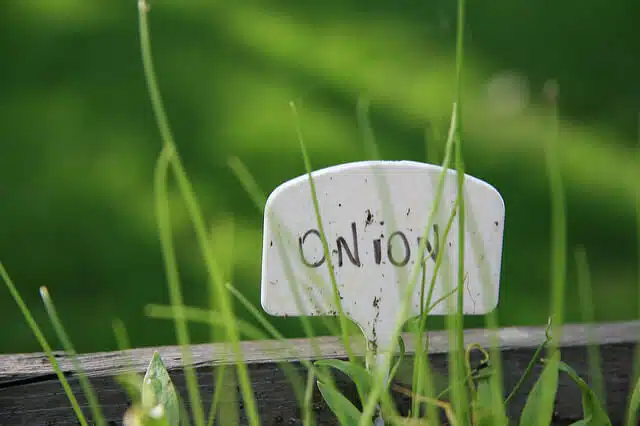Onions are near-permanent inhabitants of the home-growers pantry.
As a container grower, however, you might be drawn to more exotic veggies. And that’s completely understandable. Onions are inexpensive and available year-round in the supermarkets. However…
There’s just something about them. There’s nothing like having your own carefully-tended onions hanging up in a shady spot in the kitchen.
You might even want to try your hand at growing giant show onions (I’ve included some links at the bottom).
Whatever your motivation, this guide will ensure you get the best harvest possible from your pots.
Factsheet & general notes
You have three choices: spring onions, cocktail onions or full-sized bulbs. Whichever you choose, it’s advisable to go for the smaller varieties (I’ve included links below).
You sow and care for both shallots and onions in the same way. The only difference between them is that shallots form clusters like garlic.
| Sprouting time: | 2 – 3 Weeks |
| Time from sowing to harvest: | 6 Months (Sown in Spring) 12 Months (Sown in Autumn) |
| Size of pot: | Large |
| Difficulty of growing in pots? | Easy – Medium |
Sowing and harvesting calendar
You can plant or sow either in Spring or Autumn (for overwintering).
Sow: Mid-February to Mid-April (for summer crops) and August to mid-September for overwintering.
Harvest: July to September
Potting soil tips
- If you intend to buy store-bought compost or potting mix, add a few handfuls of drainage material – horticultural sand works well – along with a good dose of slow-release fertiliser. Alternatively, you will need to feed weekly or bi-monthly with a liquid fertiliser through late spring and summer.
- If you plan to make your own mix, a standard home-made mix will work well. Add some extra drainage material like horticultural sand. Ensure a pH of 7 or thereabouts. Onions don’t like acidic soil. Lime if you’re using peat.
- Coir, sand and compost/manure in equal measure, with added fertiliser (preferably including micro-nutrients), make up a good home-made mix.
Sowing and planting
- Sow in spring for a summer harvest, or in autumn for an early summer harvest the next year.
- For a late summer crop plant in February, March or early April.
- For an early summer crop, you will need to sow in August and let the bulbs over-winter. August is the time to do this with a cold-hardy variety. Japanese varieties are a popular choice.
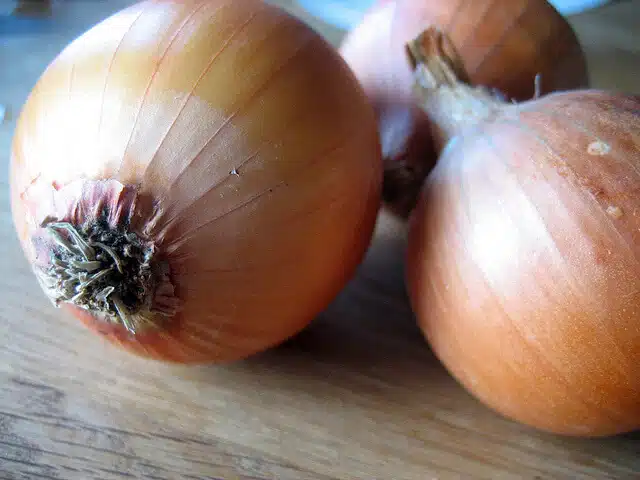
- You can grow onions from sets (small onions eager to start bulking up on your lovely nutritious potting mix) or from seed.
- The two benefits of using sets are that they mature faster and are resistant to pests. On the downside, they are a tad more likely to bolt. You can mitigate this risk by ensuring you water thoroughly through summer.
- Plant onion sets about 3 inches apart from each other, with the tips just poking out of the soil.
- If you’re transplanting, make sure the roots fall vertically into the hole, firm up the potting mix and water well.
- Shallot sets are full-sized and will grow into clusters of ten or so similar-sized bulbs. It’s important to give shallots more space for this reason.
- If starting from seed, you have a more diverse set of varieties to choose from. The trade-off is a longer growing season.
- Some varieties may be better suited to summer or autumn sowing, and some have to be grown at a certain time, so do a little research before buying. I’ve included some variety advice below.
- Germination can take up to three weeks. If you want to get going in early spring, your best bet is to provide a warm(ish) and stable temperature. An unheated greenhouse or a not-too-warm windowsill are both good options.
- Scallions (spring onions) and cocktails onions will need around four months in the ground before they’re ready to harvest, depending on how big you want them.
- If you want to get off to a really early start, you can sow on a bright windowsill in February. Let the seedlings grow in a plug tray and, when the time comes, ease them out and pop them into a dibbled hole, making sure, as mentioned, the roots go in vertically and the bulb base is at least 1cm (1/2 in.) below the soil line. Firm them in and water well.
- Allow a 3 in./8cm circumference around plants in pots. Spring onions require less (1 in./2cm).
Growing tips
- Feed with a balanced NPK liquid feed if you didn’t add any slow-release fertiliser when you prepared the potting mix.
- Use a liquid micronutrient feed (something like liquid or calcified seaweed) twice a month to ensure healthy growth.
- Bolting can be an issue. Pay close attention to watering through the dry months to avoid any problems. If the onions do bolt, snip off the flower stems. They should be ok.
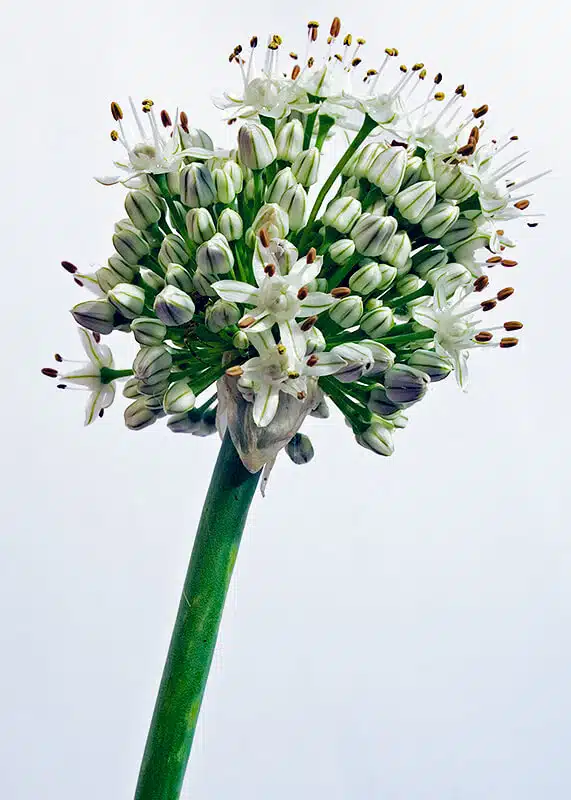
- You can plant onions quite closely in pots. Just remember that the less space you allow, the smaller they will be.
- If you find that sets have been tugged out of the soil by birds, just push them back in.
Harvesting & storage
- Both onions and shallots are almost ready to harvest when the foliage has turned yellow died back a little. When this happens, leave them for a further week or two before pulling them.
- Once you’ve got your onions out of the ground it’s time to cure and hang them (which is almost as good as eating).
- Use onions with small amounts of rot (or soft spots) immediately.
- Cure by letting the onions dry in the sun (or a warm, dry place) until the stems are crisp and the skin is papery. Tidy them up by trimming the roots and removing any very loose skin. This can take anywhere from one to three weeks.
- If you want to go down the traditional route, you can use the tops (died back foliage) to plait them together. Alternatively, you can hang them with some string (see the “More Resources” section below).
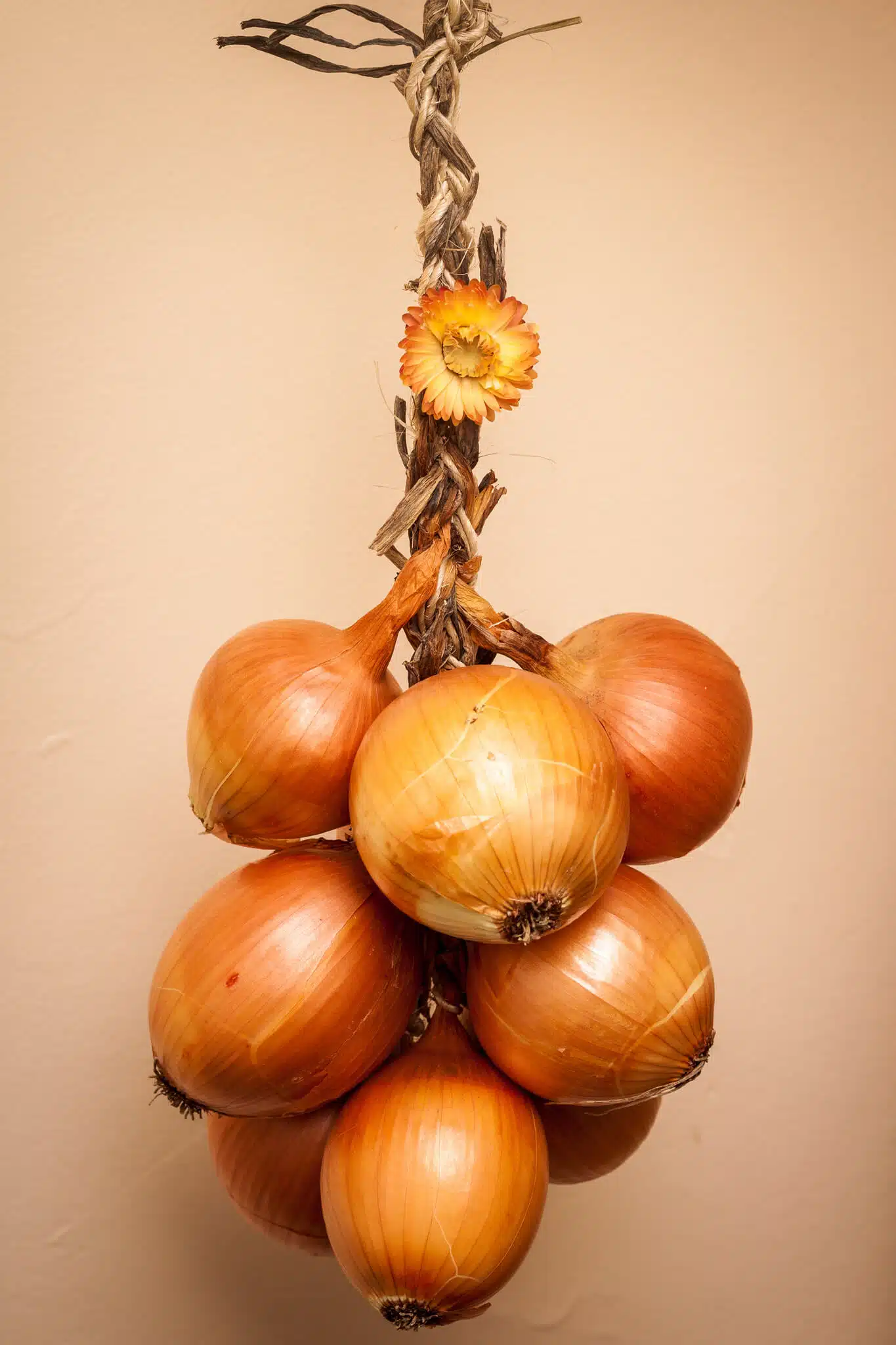
- Onions will keep for up to six months through the winter, as long as they’re stored in a cool, dry place. They’re best hung somewhere that’s reasonably light.
Pests and problems
- By growing in containers, you’ll automatically overcome many of the common problems associated with growing onions. There won’t be any overwintered onion fly pupae in your soil (from which the flies emerge at the end of spring) so it’s unlikely you’ll have any attacks. The same is true of eelworm. Problems associated with lack of watering (such as splitting at the base) are more likely.
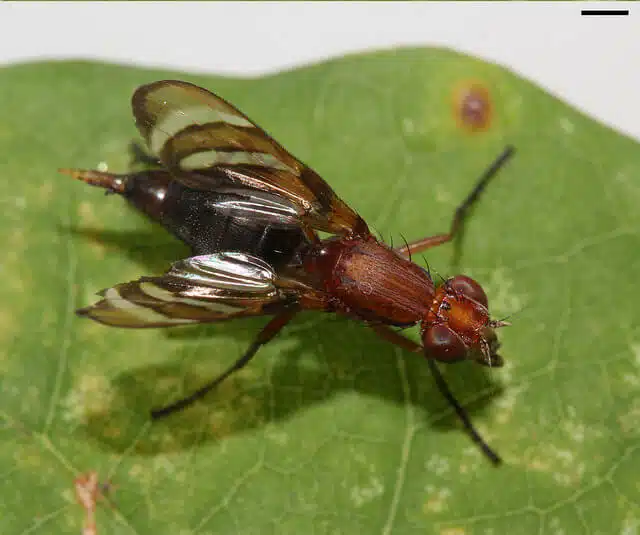
- Birds sometimes have a tendency to uproot newly planted sets. Protect them with a little netting if your garden or balcony is a hot-spot for unwelcome feathered friends.
- Onions can sometimes rot after they’ve been stored. Improper inspection (for rot) or drying is usually the culprit. Regularly check your stored bulbs and be on the lookout for damaged ones.
Good onion varieties for pots
Good varieties for US growers include:
Copra – Good compact onion variety with a great taste. It’s very well-suited to storage, lasting for up to twelve months.
Cippolini Red – Small, disc-shaped onions with a purplish skin and intense flavour.
Good varieties for UK growers include:
Paris Silver Skin – The quintessential pickling onion that’s usually picked when the bulbs are the size of a large grape.
Rosanna – One of my favourites. Rosanna “pink” onions tend towards the smaller side and have a delectable flavour.
Cooking with your onions
Onions are one of the Western world’s oldest and most-used veggies. As such, I probably don’t need to offer much advice.
One quick point. If you want to really appreciate the taste of your home-grown produce (which will undoubtedly be better than shop-bought equivalents) then use them raw in a salad. If they’re too hot, just parboil slightly for 30 seconds.
More Resources
There are so many onion varieties to choose from, along with a wealth of container growing advice, likely because of the tendency of show-growers to use pots. They also have a fascinating history and cultural significance. Did you know, for example, that certain Hindu sects won’t eat onions on the basis that they can’t be offered to deities?
Here are a few interesting links:
What are your thoughts? Leave a comment below!
Have you tried growing onions or shallots in containers? Leave a comment below and let me know how it went!
Image credits: martini777, David Hill, Marissa Huber, Spookygonk, Tim Sackton.
